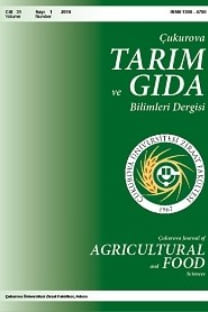Feromonların Sığır Yetiştiriciliğinde Kullanımı Üzerine Çalışmalar
Feromon terimi, bir hayvan tarafından harici olarak idrar, dışkı veya deri bezlerinden salgılanan ve aynı türün alıcısında belirli bir reaksiyona neden olan hava yoluyla ulaşan kimyasal maddeleri ifade etmektedir. Feromonlara tepki, belirli bir davranış veya alıcı endokrin veya üreme sisteminde fizyolojik değişim süreçlerini içerir. Bunlar endokrin sistem üzerinden bir davranışın engellenmesi, uyarımı veya hazırlanması için gerekli fizyolojik olayları tetikleyen maddelerdir. Genellikle, birçok türün dişi idrar ya da vajinal salgılarında olduğu ve türün erkeklerinde kokuya bağlı farklı tepkilere neden olan koku işaretleri olarak bilinir. Bu işaret kokuları östrus ve proestrus dönemlerinde salınmakta olup başka dönemlerde bulunmazlar. Dişi idrar ve dış genital bölgesini koklayan erkek birey bu şekilde dişinin kızgınlık dönemi hakkında net bilgi sahibi olmaktadır. Bu çalışmanın amacı sığır yetiştiriciliğinde üreme performansının etkenliğini artırmak amacıyla sığır üreme feromonları, özellikleri ve biostimulationun rolü ile bu konuda yapılan çalışma sonuçlarının derlenmesi amaçlanmıştır
Anahtar Kelimeler:
Sığır Üremesi, Feromonlar, Biostimulasyon
The studies on Pheromones and Using Possibilities in Cattle Reproduction
The term pheromone refers to air-borne chemical substances that are secreted externally by an animal in urine, feces or secreted by cutaneous glands and cause a specific reaction in a receiving individual of the same species; the reaction involves either the release of a specific behavior or physiological change in the recipient’s endocrine or reproductive system. These are substances that cause physiological events either through inhibition or stimulation in which endocrine, reproductive and other systems could be altered. Usually, it involves an olfactory cue that elicits a measurable physiological response. Olfactory cues that transmit specific information and result in specific and immediate behavioral responses in the male appear to be produced in the urine or vaginal secretions of females of many species. These odors are present at oestrus and proestrus but not at any other time. The male, through investigation of the female’s urine and anogenital region can use these olfactory cues to determine the stage of the female’s oestrus cycle. The aim of this study is to examine the role of pheromone(s) and biostimulation in cattle reproduction that would provide information of interest for cattle husbandry for enhancing reproductive performance
Keywords:
Pheromones, Biostimulation, Cattle Reproduction,
___
- Archunan, G., Rameshkumar, K. (2012) 1- iodoundecae an estrus indicating urinary chemosignal in bovine (Bos taurus). J.Vet. Sci. Tech. 3: 121-123
- Archunan, G., (2008) Identification of putative pheromones in bovine (bos taurus) faeces in relation to estrus detection. Animal Reproduction Science, 103 (1–2), pp. 149–153
- Archunan, G. (2009) Vertebrate pheromones and their biological importance. J. Exp. Zool. India; 12: 227–239.
- Dominic, C. J. (1991) Chemical communication in animals. J. Sci. Res. (Banaras Hindu University) ; 41: 157–169.
- Doty, R. L., (1976) Mammalian Olfaction, Reproductive Processes and Behaviour. Academic Press, New York, USA.
- Estes, R. D. (1972) The role of the vomeronasal organ in mammalian reproduction. Mammalia 36: 315-41.
- Ha, T.S., Smith, D.P. (2006) A pheromone receptor mediates 11-cis-vaccenyl acetate-induced responses in Drosophila. J. Neurosci. 26(34): 8727-- 8733.
- Hafez, E S E and Bouissou, M F. (1975) Mating behaviour in animals. In The behaviour of domestic animals (Ed) Hafez E S E. pp.203–45.Bailliere,London.
- Hradecky, P., Sis, R.F, Klemm, W.R. (1983) Distribution of flehmen reactions of the bull throughout the bovine estrous cycle. Theriogenology. ;20:197–204.
- Izard, M.K. (1983) Pheromones and reproduction in domestic animals. In: Vandenberg J.G, editor. Pheromones and Reproduction in Mammals. Academic Press; New York: pp. 253–285. In.
- Kiddy, C.A, Mitchell D.S. (1984) Estrus-dated odors in cows: Time of occurrence. J. Dairy Sci. 64: 267.
- Klemm, W., R,Hawkins G.N. (1987) Idenrification of compounds in bovine cervico-vaginal mucus extracts that evoked male sexual behaviour. http://chemse.oxfordjournals.org/content/ 12/1/77.short
- Preti, G., (1984) Method for detecting bovine estrus by determining methyl heptanol cocantrations in vaginal secretions. United States Patent No. 4,467, 814, Aug. 28, 20 pages.
- Rajkumar, R., Karthikeyan, K., Archunan, G., Huang, P.H, Chen, Y.W, Ng, W.V, Liao, C.C. (2010) Using mass spectrometry to detect buffalo salivary odorant-binding protein and its post-translational modifications. Rapid Commun. Mass Spectrom.
- Rekwot, P.I., Ogwu, D., Oyedipe, E.O. (2000) The influence of bull biostimulation, season and parity on resumption of ovarian activity of Zebu (Bos indicus) cattle following parturition. Anim Reprod Sci. 2000 Oct 2;63(1-2):1-11.
- Rivard, G., Klemm, W.R. (1989) Two body fluids containing bovine estrous pheromone(s). Chemical Senses Vol. 14 no.2 pp.273-279
- Salazar, I., Quinteiro, P.S, Cifuentes, J.M. (1995) Comparative anatomy of the vomeronasal cartilage in mammals: Mink, cat, dog, pig, cow and horse. Ann. Anat. Jul;177(5):475-81.
- Sambraus, H.H., Waring, Z. (1975) Effect of urine from estrous cows on libido in bulls. Zoologie Saugettierkunde. 40: 49–54.
- Sankar, R., Archunan, G., Habara, Y. (2007) Detection of oestrous-related odour in bovine (Bos taurus) saliva: Bioassay of identified compounds. Animal 1: 1321– 1327.
- Sankar, R., Archunan, G. (2011) Gas chromatographic / mass spectrometric analysis of volatile metabolites in bovine vaginal fluid and assessment of their bioactivity. Int. J. Anal. Chem. Article ID 256106.
- Sankar, R., Archunan, G. (2008) Identification of putative pheromones in bovine (Bos taurus) feces in relation to estrus detection. Anim. Reprod. Sci; 103: 149– 153.
- Sannmann, I., Heuwieser, W. (2014) Technical note: Intraobserver, interobserver and test- retest reliabilities of an assessment of vaginal discharge from cows with and without acute puerperal metritis. Journal of Dairy Science, Vol. 98, Issue 8, p5460 –5466 Published online: May 28. 2015
- Stahlbaum, C. C., Houpt, K. A. (1989) The role of flehmen response inthe behavioural repertoire of the stallion. Physiology and Behavior. 45, 1207 – 1214.
- Vandenbergh, J. G. (1999) In Encyclopedia of Reproduction. Academic Press; London: Pheromones in mammals Academic Press, London, pp. 764 –769.
- Weigerinck, W., Setkus, A., Buda, V., BorgKarlson, A.K., Mozuraitis, R., (2011) BOVINOSE: Pheromone based sensor system for detecting estrus in dairy cows. Procedia Comput. Sci. 2011; 7: 340–342.
- ISSN: 2636-7874
- Başlangıç: 1973
- Yayıncı: Çukurova Üniversitesi
